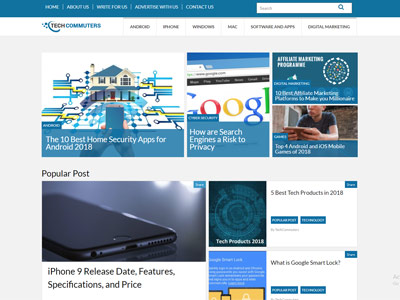The Best tech blog: Your Vital Guide to Navigating the Digital World
The Best tech blog: Your Vital Guide to Navigating the Digital World
Blog Article
Comprehending the Rise of Side Computing in Today's Digital World
In the swiftly evolving landscape of technology, side computer becomes a pivotal force, reshaping how information is refined and utilized. This standard change is driven by the spreading of IoT tools and a rising demand for immediate information processing. By transitioning data management closer to the source, side computer addresses crucial latency issues while enhancing bandwidth usage and improving security measures. As industries pivot towards smarter, a lot more reliable systems, understanding the nuances and ramifications of this technical innovation ends up being vital. What does this mean for future advancements and the digital ecosystem all at once?
What Is Side Computer
Edge computing, although a relatively recent improvement in the world of modern technology, fundamentally transforms how information is refined and managed by bringing computation and information storage space closer to the area where it is required. Unlike conventional cloud computer versions, which typically rely upon centralized data facilities that can be geographically far-off, edge computing decentralizes data handling. This closeness lowers latency, improves real-time information processing, and improves the overall user experience by making sure much faster feedback times.
At its core, edge computer includes a network of localized tools and facilities, such as entrances, sensing units, and routers, capable of processing information at or near the source. This localized handling capacity is particularly essential for applications needing immediate data analysis, such as independent automobiles, commercial automation, and wise cities. In addition, by offloading information handling jobs from main servers, edge computer decreases data transfer needs and boosts data privacy and safety, as delicate details can stay on-site as opposed to going across comprehensive networks.

Secret Motorists of Fostering
Numerous elements are driving the adoption of edge computer in today's electronic landscape. Edge computing addresses this need by enabling data processing closer to the data resource, lowering latency and improving real-time decision-making abilities.
Another substantial chauffeur is the need for enhanced data transfer performance. Centralized cloud systems can come to be overloaded with the sheer volume of information produced by IoT gadgets, bring about traffic jams (Best tech blog). By refining data at the edge, organizations can relieve network blockage and enhance overall system performance
Moreover, safety and security and privacy problems are pressing companies toward side computing. By refining sensitive data locally, business can reduce risks associated with data transmission and direct exposure to possible cyber hazards.
The surge of applications calling for real-time handling, such as autonomous automobiles and enhanced reality, also requires the rapid reaction times that edge calculating supplies. Jointly, these motorists are making edge calculating a vital element of modern-day IT infrastructure, paving the method for its widespread adoption throughout different sectors.
Benefits Over Cloud Computing
Just how does edge computer identify itself from typical cloud computer? Mainly, side computer brings information handling closer to the source of data generation, commonly on neighborhood devices or close-by servers, rather than depending on centralized information. This proximity considerably reduces latency, allowing real-time data handling and decision-making. For industries where milliseconds issue, such as self-governing lorries or industrial automation, the lowered latency provided by side computer can be crucial.
In addition, edge computing improves bandwidth efficiency (Best tech blog). By refining data in your area, only the essential information is sent to the cloud for further analysis or storage, decreasing the volume of data that traverses the network. This not just eases network blockage yet additionally reduces data transmission prices
Edge computer additionally supplies improved data privacy and safety and security. Sensitive information can be processed in your area without being sent to the cloud, decreasing the direct exposure to possible cyber hazards. This is especially visit this page helpful for markets managing secret information, such as healthcare and economic solutions.
In addition, edge computer makes sure greater strength and integrity. Neighborhood handling enables continued operation also when connectivity to the cloud is compromised, keeping necessary features and services regardless of prospective network disturbances. These benefits jointly demonstrate edge computing's transformative potential in maximizing performance and safety and security in electronic communities.
Challenges and Factors To Consider
While side computing uses countless advantages, it likewise presents distinct difficulties and considerations that have to be dealt with to totally realize its potential. Additionally, managing and checking a decentralized network of edge tools can be complex, calling for sophisticated devices and approaches to make sure seamless operation and upkeep. Best tech blog.
An additional factor to consider is the scalability of side computing remedies. As the variety of linked devices expands, so does the need for processing power at the side, which can cause source restrictions. Organizations has to very carefully intend their facilities to fit this growth without jeopardizing efficiency or efficiency.
Interoperability is one more critical factor. With various software and hardware elements entailed, guaranteeing compatibility and seamless integration can be tough. Standardization efforts are important to assist in communication between inconsonant systems.
Future Trends in Side Computing
Anticipating the future, side computing is positioned to revolutionize various sectors by enabling quicker data handling and lowering latency. As the volume of information generated by IoT gadgets remains to grow, edge computing will certainly end up being progressively important in handling this influx effectively. One significant fad is the combination of man-made intelligence at the edge, enabling real-time analytics and decision-making without relying on cloud-based sources. This change is prepared for to boost applications in self-governing vehicles, wise cities, and medical care, where prompt data handling is vital.
An additional emerging trend click is the growth of edge-native applications made particularly to take advantage of the one-of-a-kind capacities of side computer. These applications will certainly optimize performance and source usage, causing my company increased efficiency across various sectors. Moreover, developments in 5G modern technology will certainly additionally bolster side computing by providing the needed framework for high-speed, low-latency interaction in between tools and edge nodes.
Verdict
Side computing's surge is driven by the proliferation of IoT gadgets and the requirement for real-time data handling, which enhances performance by decreasing latency and decentralizing data management. This technique mitigates data transfer ineffectiveness and safety concerns, assisting in innovations in applications like clever cities and independent lorries. In spite of obstacles such as framework complexity and integration, the future of side computing assures a more responsive digital community, with continued technologies forming its evolution and increasing its applicability throughout industries.
Side computing, although a reasonably current advancement in the world of innovation, basically transforms just how data is refined and managed by bringing calculation and information storage space closer to the area where it is needed. Unlike typical cloud computer versions, which often depend on centralized information facilities that can be geographically remote, side computing decentralizes information handling. Additionally, by unloading data handling tasks from central servers, side computer minimizes bandwidth demands and boosts data personal privacy and safety, as delicate information can stay on-site rather than going across extensive networks.

Report this page